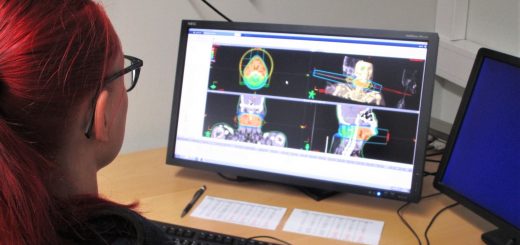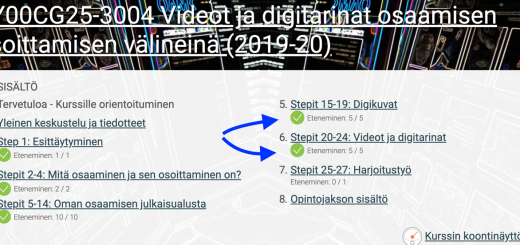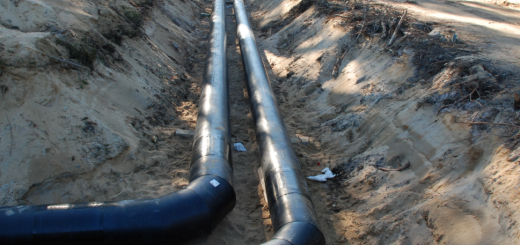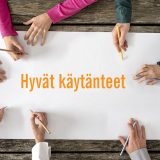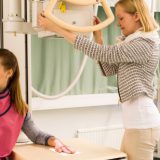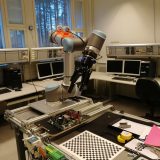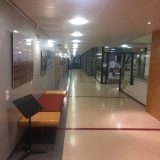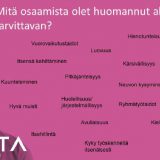Do you know what we do?
Getting to know Radiography and Radiation Therapy Studies
The second-year students of the degree programme in radiography and radiation therapy of Oulu University of Applied Sciences participated in a project-working course, where they had to plan and execute a project. The main goal was to learn project working skills, project management and teamwork, and to implement them to their profession. The students of the course were divided into five smaller groups: two presentation groups, two poster groups and one organizer group. Each group had their own assignments in the project. The project was done in co-operation with the Oulu Lyseo high school.

PICTURE 1. Tiija Oivakumpu is starting her presentation (photo: Tiia Ranta)
The purpose of the project was to introduce the degree programme in radiography and radiation therapy to the high school students. The course was held in English, which is why this text is written in the same language. By introducing this degree programme to the second-year high school students and student counselors, we enable them to find new and interesting fields students can study after high school. Student counselors can also recommend this degree programme to their students. Therefore, this project was very important. The radiography and radiation therapy programme isn’t advertised a lot which is also why this project could have an impact in the future, as it might help in finding eligible students that are interested in radiography and radiation therapy.

PICTURE 2. Arriving to the Oulu Lyseo high school (photo: Tiia Ranta)
Planning and implementation
In the beginning we brainstormed ideas and decided to introduce our profession to the second-year students of Oulu Lyseo high school. This subject is a current topic for the students since they will apply to universities next year. Our profession is not well-known compared to the other degree programmes in the social and health care field, which is why we considered that the subject is important. We had three meetings held in English. In those meetings we narrowed down the topic and decided to perform our presentation using PowerPoint.
Since the audience was Finnish, the oral presentation was held in Finnish. A classroom was reserved for the presentation. The time given was 20 minutes per presentation group. There were 15 people in the audience.
The project was divided into two sections that included radiography and radiation therapy studies and working life. Posters were done to the support the presentation and they were left in the school’s bulletin boards. Leaflets were also provided by the poster group.

PICTURE 3. And now it is Laura Pulska’s turn to give her presentation (photo: Tiia Ranta)
Degree Programme in Radiography and Radiation Therapy
The studies last 3,5 years on average and consist of 210 credits that include academic studies and practical training. The academic studies consist of radiography and radiation therapy, basic skills of social and health care, communication skills and research and development studies. The bachelor’s thesis is included in the studies. All studies lead students to work in radiation therapy and diagnostic radiography. Practical training includes all modalities and lasts 2-6 weeks. They are done every year and students are divided into all fields. Next year the programme will be done as a multiform learning. It means that the students will study once a month in school for a week [1].
Project working
To ensure that the project is executed properly, the project management is needed. Project management includes the information, skills, methods and tools with which the goals of the project are achieved. The needed skills at project management are both hard and soft. The hard ones are information of the project planning, execution, and knowledge of information technology and the soft ones are skills at working with the people. [2]. The success or failure depends on the projects risk management [3].
The project is a process with predetermined goal, where a temporal group of people together perform a seeking process within a certain timeline and with predetermined expenses. There are different types of projects and ours was an event project. In any project type the process is the same. First is the foundation, then the planning and then the actual execution and finally the closure. During the foundation the group does the ideation. Ideation is the most important part of the project and success at it most likely leads the whole project succeeding. [2]
The project was easy to execute because we had good instructions that we were able to implement in our work. The objective was clearly defined in the first meeting which our whole class took part. Therefore, it was effortless to continue from this and our group was motivated to see this project through as a team. We learned how to work together in a group and how to succeed in project working. In our meetings, we learned how to take meeting minutes. This will help us in our future profession because we might have to take meeting minutes. We think that during this course we all learned a very good base for project work and it will be a great help in the future.
Tiija Oivakumpu, Tiia Ranta, Erkki Pöyhönen, Milja Kantola, Laura Pulska & Karoliina Illikainen
Students of Degree Programme in Radiography and Radiation Therapy
Aino-Liisa Jussila, Senior Lecturer, Oulu University of Applies Sciences
References
[1] Oulu University of Applied Sciences. 2018. Radiographer (AMK), multiform studies. Referred 3.5.2018. http://www.oamk.fi/fi/koulutus/amk-tutkintoon-johtava-koulutus/rontgenhoitaja/rontgenhoitaja-amk-monimuotototeutus/
[2] Carver, E., Kamppari, K., Kymäräinen, H-R. & Lakkala, M. 2016. Opas projektiotyöskentelyyn. Referred 23.4.2018.
https://helda.helsinki.fi/bitstream/handle/10138/160099/Opas_projektity%C3%B6skentelyyn_2016.pdf?sequence=1
[3] Pekkinen, L. 2015. Information processing view on collaborative risk management practices in project networks. Doctoral dissertation. Acta Universitatis Ouluensis C, Technica 551. Referred 23.4.2018. http://jultika.oulu.fi/files/isbn9789526210162.pdf
Julkaisun pysyvä osoite:
http://urn.fi/urn:nbn:fi-fe201901212630

